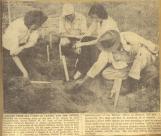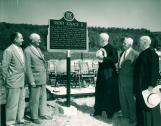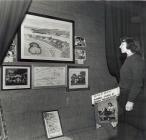1
The Martyrs' Shrine, located outside Midland, Ontario, was established by the Society of Jesus in 1925-1926. The Jesuits based at the Shrine and elsewhere in North Americaa were pivotal in arranging the beatification in 1925 and canonization in 1930 of the eight North American Jesuit martyrs: Jean de Brebeuf, Isaac Jogues, Gabriel Lalemant, Antoine Daniel, Charles Garnier, Noel Chabanel, Rene Goupil and Jean de La Lande. The first six of these eight martyrs as listed here spent varying amounts of time at Sainte-Marie I and other Jesuit Mission sites in Huronia between 1642 and 1649.Two of the Directors of the Martyrs' Shrine, Father J.M. Fillion in 1926-1928 and Father T.J. Lally from 1928 until his death in 1952, were primarily responsible for initiating , encouraging and making the arrangements for the eventual archaeological investigations at the sites where some of these martyrs had walked and been martyred. All of those familiar with the archival documents knew that Father Daniel had been captured and killed at the site of Teanaostaiae (St. Joseph II) and that Father Brebeuf and Lalemant had been captured by the Iroquois at the site of St.Louis before they were taken to the site of St.Ignace II and put to death on March 16, 1649. The partially preserved ruins of the site of St. Marie I ere identified as early as 1844 as being worthy of excavation and restoration. These options became viable when the land containing the site of Sainte-Marie I was obtained by the Society of Jesus in 1940. The Jesuits immediately arranged for the first major excavation project in Huronia in 1941 at Sainte-Marie I with the Royal Ontario Museum's Kenneth Kidd hired to oversee those excavations.
2
In the meantime, the property containing the site was acquired by the Society of Jesus and a stone altar was erected there to commemorate Brebeuf and Lalemant. The Jesuits appealed to Fox for assistance in arranging further investigations of the site, and Wilf resumed excavations there in 1946. His fieldwork included uncovering a structure that he interpreted as the Jesuit church or chapel. Wilf also undertook a partial reconstruction of the site, involving the frame of a longhouse and segments of the palisades. For his efforts there, Wilf received a special blessing for Pope Pius XII in 1946.3
Newspaper article on excavations at St. Ignance IIc. 1958
Midland, Ontario, Canada
 Credits:
Credits:Museum of Ontario Archaeology
4
University of Western Ontario's President W. Sherwood Ofx and Librarian Fred Landon were approached by concerned citizens and historians Alphonse Arpin and Thomas Connon in 1934 with the idea of investigating the site of St. Ignace II. Fox, himself a noted historian with some archaeological training in Classics, took up the challenge. With Wilf's assistance arrangements were made for William J. Wintemberg of the National Museum of Canada to excavate the site. Wintemberg conducted excavations at St. Ignace II in 1937 and 1938, but his untimely death in 1941 and the country's preoccupation with World War II put an end to this first phase of investigation. However, Fox and Jury obtained Wintemberg's field notes and unpublished manuscripts about St. Ignace II, and communicated the results through their own presentations at meetings of the Royal Society of Canada and in subsequent publications.5
Plaque at St. Ignace II site, location of Jesuit Fathers Brebeuf and Lalemont executions, 1649August 21, 1960
Waubaushene, Ontario, Canada
 Credits:
Credits:Museum of Ontario Archaeology
6
In the process of the Society of Jesus acquiring the property containing the site of Sainte-Marie I in 1940, Father Lally of the Martyrs' Shrine had tried to convince the National Museum of Canada to have William J. Wintemberg excavate the site. Wintemberg's ill health prevented this, so the Martyrs' Shrine entered into agreements that would result in Kenneth Kidd of the Royal Ontario Museum of Archaeology initiating excavations at Sainte-Marie I in 1941-1942. At the same time arrangements were made for Wilf and the University of Western Ontario to excavate St. Ignace II, but not until 1946. Kidd's excavations at Sainte-Marie I were confined to what was then thought to be the full extent of the site within the remnants of four partially preserved stone bastions.7
Wilf excavating at Sainte-Marie I site1951
Midland, Ontario, Canada
 Credits:
Credits:Museum of Ontario Archaeology
8
In the fall of 1947 workmen were restoring one of the stone bastions at Sainte-Marie I. It so happened that these workmen had previously been with Wilf at St. Ignace II and Flanagan, and so they knew what a post mould looked like. They observed a row of post moulds extending out from the stone bastion, away from the area previously excavated by Kidd. They told Father Lally, who contacted Wilf and asked him to come up to have a closer look. Wilf later wrote of that day: "Little did I realize what the discovery meant nor did I realize what the turn of events would lead to. Fate or fortune like the flip of a card was to place me in position to once again turn my study to the missionaries that as a boy I wanted to know more about" (Wilfrid Jury, 1972 autobiography).9
Summer School of Archaeology at Sainte-Marie I site, French Jesuit Mission in Midland, 1639-1649circa 1950
Midland, Ontario, Canada
 Credits:
Credits:Museum of Ontario Archaeology
10
Wilf's brief investigations beyond the bastion at Sainte-Marie I in the late fall of 1947 proved the site was far larger and much more complex than anyone had previously thought. Wilf continued excavations at Sainte-Marie I for four years (1948-1951), while Elsie completed extensive archival research about the site and its occupants.11
Advertisements for the Summer School of Archaeologycirca 1958
Midland, Ontario, Canada
 Credits:
Credits:Museum of Ontario Archaeology
12
All of those connected with the project, but especially the Society of Jesus, the University of Western Ontario, the Huronia Historic Sites and Tourist Association and the provincial government, recognized the enormous educational and interpretive value of such a long-term project. The on-going excavation was visited by thousands upon thousands of people , from school students, tourists and the general public to a long list of dignitaries.Wilf, and to a lesser extent Elsie, came to be nationally recognized via newspaper stories and magazine articles, radio interviews, television coverage and films associated with or about "Fort Ste. Marie".13
Elsie at Sainte-Marie Icirca 1963-1967
Midland, Ontario, Canada
 Credits:
Credits:Museum of Ontario Archaeology